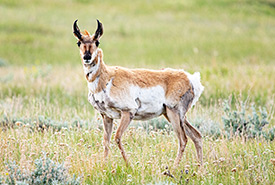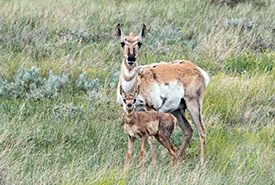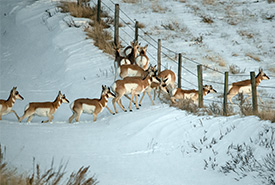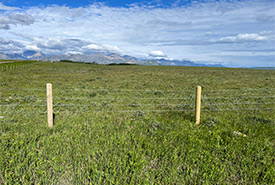Sustaining our grassland speedsters
How NCC is reducing movement barriers for pronghorn
Pronghorn (Photo by Leta Pezderic/NCC staff)
If we want pronghorn to stick around, they must be able to move on.
Pronghorn are a unique and fascinating species, emblematic of the Prairie grasslands of the North American Great Plains. While resembling and commonly referred to as antelopes, pronghorn are most closely related to the giraffe and okapi. One of this species’ claims to fame is clocking in as the fastest land mammal in North America, with the ability to reach speeds of almost 100 kilometres per hour.
Pronghorn are also a remarkable conservation success story.
After facing decades of hunting and habitat loss post-colonialization, pronghorn brushed close with extinction; their numbers dropped to a mere 13,000 individuals by 1915, representing a 99 per cent decline from their estimated historic population of 35 million.
In response to their dwindling numbers, some of the earliest conservation efforts were launched in the 1920s, including habitat protection and captive breeding. As a result, pronghorn populations rebounded (although some subpopulations remain highly imperilled); today, about 800,000 exist, including about 32,000 in southern Alberta and Saskatchewan.
However, despite this encouraging recovery, challenges remain for this iconic prairie species.
Pronghorn's problem with fencing
Besides the continued loss and fragmentation of their Prairie grassland habitats, pronghorn face a major threat that is critical to their survival: artificial barriers.
Pronghorn undergo one of the longest migrations of any North American mammal. They do so to access different habitats throughout the year, including fawning areas (where females give birth) in the spring, summer grazing areas and overwintering areas, explains Megan Jensen, Nature Conservancy of Canada’s (NCC’s) natural area manager for southeast Alberta and wildlife specialist.

Antilope d'Amérique et son petit (Photo de Leta Pezderic/CNC)
“They migrate largely based on their seasonal needs, particularly food availability” says Megan. “They have spring and fall migrations, but not all of them migrate every year, necessarily.”
In Alberta, pronghorn typically travel about 300 kilometres to migrate, although some travel as far as 800 kilometres.
Pronghorn evolved this migration pattern when the North American prairie was primarily an open expanse of continuous grasslands. But the Prairies today have been modified extensively by people, including by the addition of countless kilometres of barbed-wire fencing.
This extensive use of barbed-wire fencing presents a massive problem for pronghorn. Unlike other large, hoofed mammals, such as deer and elk, pronghorn avoid jumping over fences; they are runners, not jumpers, after all.
“Because the landscape has changed so much over a relatively short period of time, pronghorn have not had a chance to evolve an instinct to consistently jump over fencing,” says Megan.
So instead of going over fencing, pronghorn are forced to go under. But if the bottom wire of the fence is too low, they often injure themselves on the barbs.
“If they run under a fence in a moment of panic, they can scratch their backs, which removes their fur,” says Megan. “That creates a problem for the rest of season, because all of a sudden they are injured, which can result in infection, or they are just more subject to hypothermia.”
Pronghorn will avoid low fences and find less direct routes that are easier to cross. But this makes their journey longer, which causes them to expend more energy at a time of year when food resources begin to dwindle. As a result, pronghorn can be more energetically stressed because of fencing.
Enjoying this story? Sign up for our newsletter!
Making bad weather worse
Barriers such as fencing also worsen the challenges pronghorn face, particularly winter snowstorms. Significant snowfall presents an acute survival challenge for pronghorn. Fencing and other barriers can stop a herd from relocating to an area where forage is accessible, which can prove disastrous for the species.

Antilopes d'Amérique franchissant une clôture (Photo de Leta Pezderic/CNC)
“Their patterns are very easily changed by weather,” says Megan. “If they can’t dig down into the snow to get the grass and can’t get under a fence, that can create a deadly situation where they are trapped and starve.”
A particularly disastrous event happened in the winter of 2010 to 2011, when heavy snowfall resulted in the death of many pronghorn in Saskatchewan, Alberta and Montana. Some perished because they were unable to meet the metabolic toll of surviving these conditions, while others were killed by vehicle collisions as they sought refuge from deep snow drifts along cleared roads and railways.
According to surveys by the Government of Alberta, the province’s pronghorn population showed a concerning decline of 42 per cent between 2009 and 2011.
Want to help conserve pronghorn habitat? Donate to NCC's Prairie Grasslands Action Plan today!
Turning fencing friendly
To help pronghorn move across the landscape, work has been underway to make wire fencing more transmissible for pronghorn, while still being effective in keeping cattle in. This work has been led by Paul Jones with the Alberta Conservation Association.

Widlife Friendly Fence (Photo by Adam Moltzahn / NCC Staff)
There are many fencing modifications that can help wildlife, but one of the main approaches is raising the bottom wire to at least 18 inches tall, and using smooth wire, rather than barbed. This has been shown to help pronghorn move more directly, without risking injury.
“This helps pronghorn move under the fence, but other animals will go under as well. If they don’t have to expend that energy by going over, they won’t,” says Megan. “So, it just makes it a lot easier for these species to move around the landscape.”
Making movement easier for pronghorn might be helping their populations recover once again. Pronghorn populations in Alberta are now showing a steady recovery (up to 15 per cent increase per year), with the exceptions of a slight decline between 2014 and 2015, and an 18 per cent decline between 2017 and 2018.




